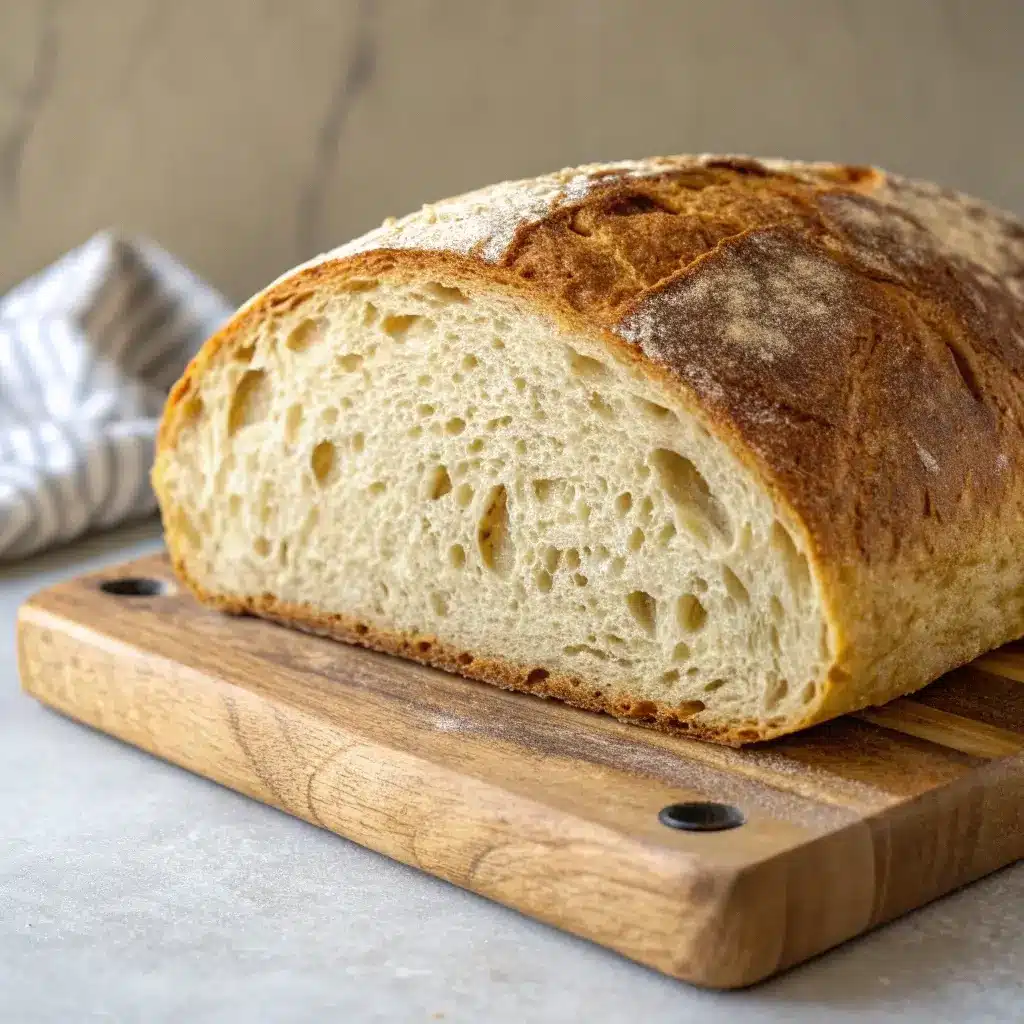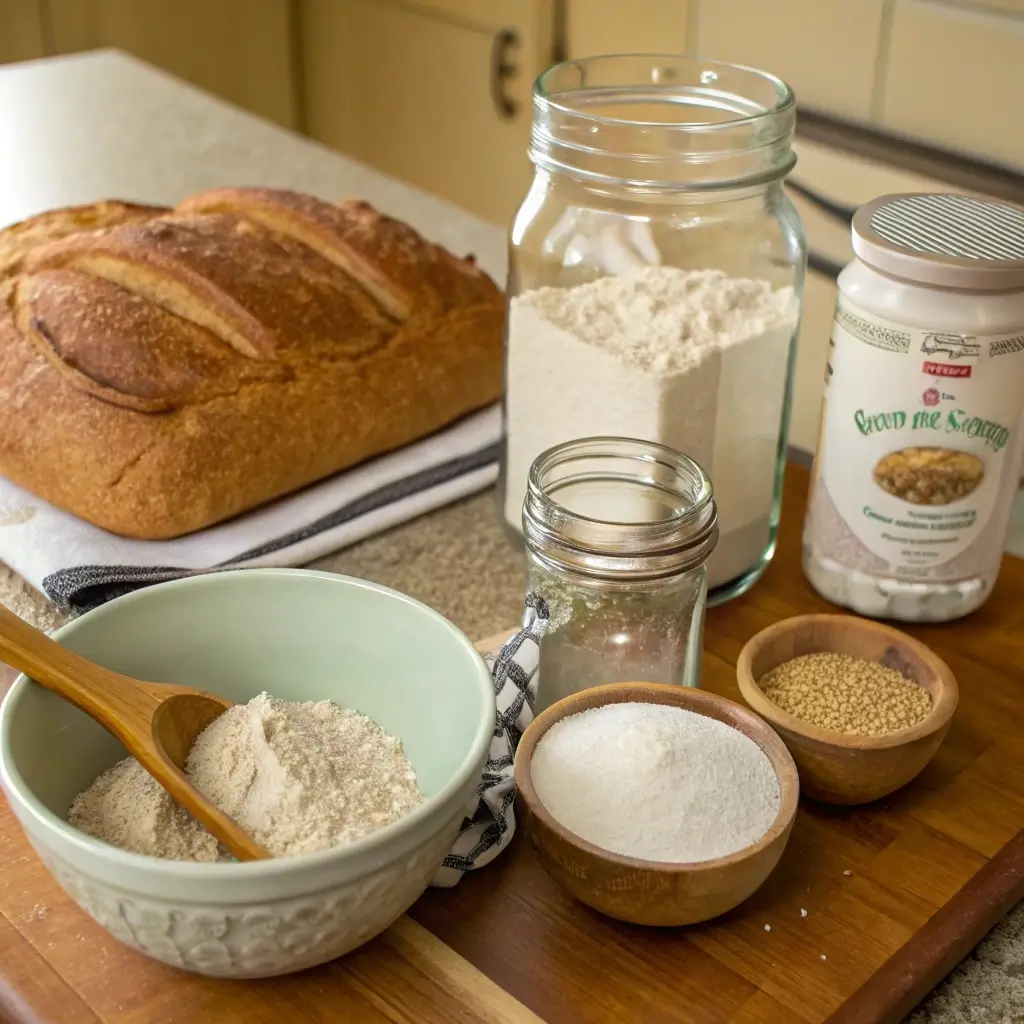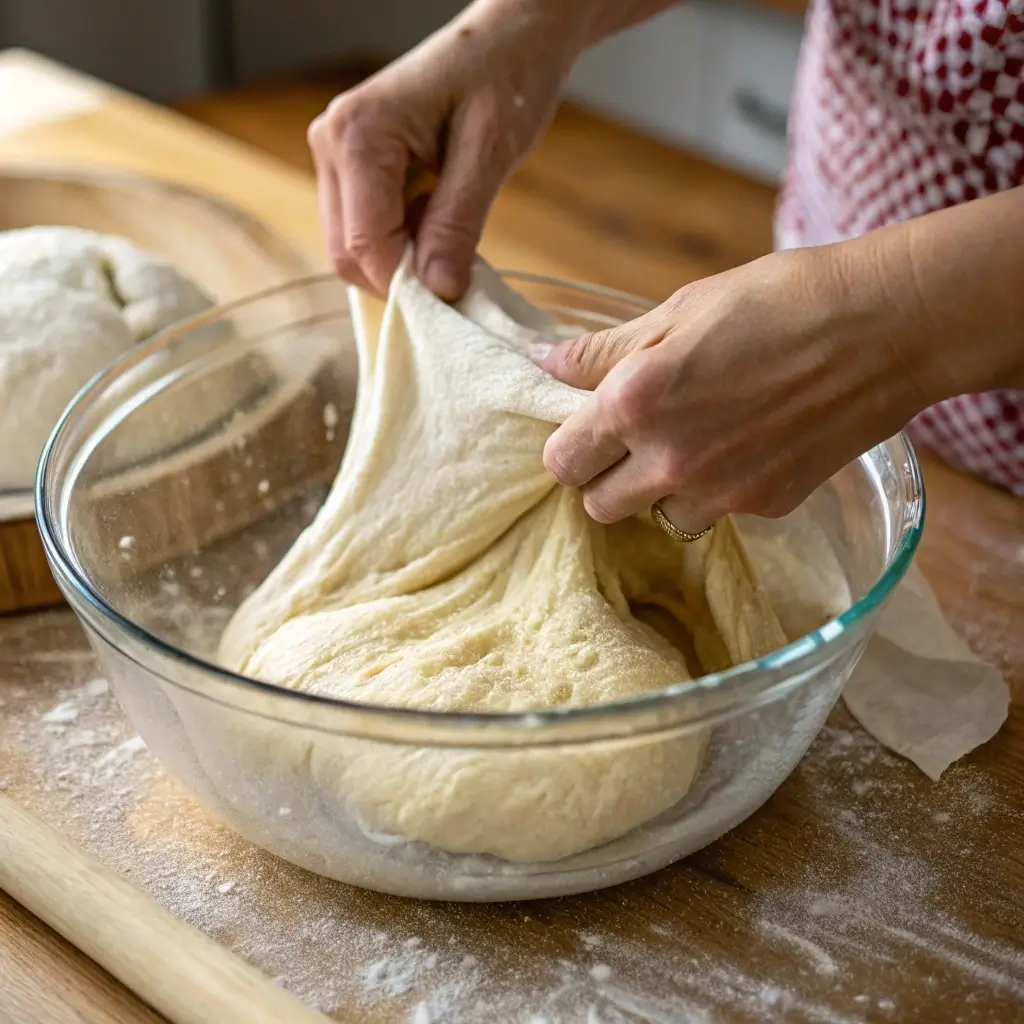Low Calorie Sourdough Bread That Tastes Amazing
There’s something magical about a warm, crusty slice of sourdough straight from the oven. But if you’re watching your calories, bread can feel like a guilty pleasure. That’s where low calorie sourdough bread comes in—it’s the perfect balance of wholesome flavor and lighter nutrition. In this post, you’ll learn exactly how to make sourdough that fits into a healthy lifestyle, with smart flour swaps, portion tricks, and fermentation techniques that naturally reduce calories. Whether you’re managing your weight or just want to eat more intentionally, low calorie sourdough bread offers all the satisfaction without the calorie overload.
Table of Contents

Why I Needed a Low Calorie Option
My love affair with sourdough started during the chaos of raising twin boys in Santa Barbara. They were picky eaters, and I was a tired mom trying to cook from scratch without losing my mind—or my grocery budget. Bread was always a comfort food in our home, but I knew I needed a version that was healthier and didn’t pack in unnecessary calories. That’s when I began experimenting with low calorie sourdough bread. I wanted the flavor and texture of artisan loaves without the heaviness, and I needed it to be something my boys would actually eat.
So I rolled up my sleeves, made plenty of messes, and taught myself how to lower the calorie count in every slice. I played with different flour combinations, adjusted the hydration, and learned the ins and outs of fermentation. The result? A tangy, chewy, golden-crusted loaf that was lighter on calories but big on satisfaction.
This version of low calorie sourdough bread helped me and my family stay full and energized without the blood sugar crash that came from standard white bread. Plus, making it at home gave me full control over the ingredients—no hidden sugars, no preservatives, and definitely no regrets. I even paired it with smart, gut-friendly meals like this low-cal pink salt drink for a wellness-forward combo that truly worked for us.
What Makes Sourdough Lower in Calories
You might be surprised to learn that traditional sourdough is already one of the better options when it comes to bread. The fermentation process breaks down complex starches, which helps improve digestibility and lowers the glycemic index. That’s why low calorie sourdough bread fills you up faster and keeps you satisfied longer. It’s not just about fewer calories—it’s about smarter calories.
What’s more, the ingredients used in low calorie sourdough bread are simple and clean. Most recipes skip oils and added sugars, which means fewer empty calories. When you choose whole grain flours like rye or spelt, you also boost fiber, which supports digestion and helps control hunger.
Hydration levels matter too. A dough with higher hydration produces larger loaves with airier crumbs—translation: more volume per slice with fewer calories. That’s the kind of trick every home baker should keep in their back pocket. Want to turn it into a full lifestyle shift? I’ve built out an entire guide around calories in sourdough bread that dives into the math behind it all.
Choosing the Right Ingredients for Low Calorie Sourdough Bread
Low-Calorie Flours That Work Well
When it comes to making low calorie sourdough bread, flour choice is everything. White all-purpose flour might deliver a fluffy crumb, but it adds more empty calories than its whole grain cousins. That’s why I love using a mix of whole wheat, rye, and spelt flour. These flours are naturally more nutritious and higher in fiber, which slows digestion and keeps you full longer without piling on the calories.
Oat flour is another great option—it’s mild in flavor, gluten-free, and blends beautifully into a well-balanced dough. Combining 70% whole grain with 30% lighter flours can help you keep the bread soft while still trimming calories. You’ll not only get better control over your nutrition, but your sourdough will have more depth of flavor.

This is the same approach I use in my gut-friendly recipes like this gluten-free sourdough bread method, which focuses on lighter ingredients and smarter choices. With the right flour combo, you can enjoy every bite of low calorie sourdough bread without compromise.
Natural Leavening and Hydration Ratios
Another secret to making low calorie sourdough bread is understanding hydration. A higher hydration level—meaning more water per gram of flour—creates larger air pockets in the final loaf. That translates to more volume, fewer calories per slice, and a satisfying, chewy texture. Aim for 75% hydration or higher when you’re confident handling wet doughs.
Natural leavening plays a major role here too. Using an active sourdough starter instead of commercial yeast creates a longer fermentation, breaking down more sugars and enhancing nutrient absorption. The result is bread that’s naturally lighter on your system—and on your waistline.
By sticking to a minimal ingredient list—flour, water, salt, and starter—you avoid the oils, emulsifiers, and sweeteners often hidden in store-bought options. I love pairing my sourdough with smart drinks like this homemade Mounjaro weight-loss recipe for a light and energizing start to the day.
Whether you’re baking your first loaf or tweaking your go-to recipe, keeping hydration high and ingredients clean is the best way to make your low calorie sourdough bread both satisfying and slimming.
For more fun variations and ideas, check out our Facebook and Pinterset sections where creativity meets craving.

Low Calorie Sourdough Bread That Tastes Amazing
Ingredients
Equipment
Method
- Feed your sourdough starter with whole wheat flour and water at least 6–12 hours before baking. Ensure it’s bubbly and active.
- In a large bowl, combine flours, water, salt, and starter. Stir until fully incorporated. Let the dough rest for 30 minutes.
- Perform 4 sets of stretch and folds every 30 minutes over a 3–4 hour period to build dough strength.
- Let the dough bulk ferment at room temperature for 6–8 hours or until doubled in size. Then shape and transfer to a banneton or floured bowl.
- Cover and cold-proof the shaped dough in the fridge overnight (8–12 hours).
- Preheat oven and Dutch oven to 475°F. Score the dough, then bake covered for 20 minutes, and uncovered for another 20–25 minutes.
- Cool completely on a rack for at least 1 hour before slicing. Store at room temperature for 3 days or freeze individual slices.
Nutrition
Notes
Tried this recipe?
Let us know how it was!How to Make Low Calorie Sourdough Bread at Home
Simple Step-by-Step Process
Making low calorie sourdough bread from scratch might seem intimidating, but I promise, once you do it a couple of times, it becomes second nature. The key is simplicity—sticking to just a few high-quality ingredients and respecting the fermentation process.
Here’s how I do it:
- Feed Your Starter
Make sure your sourdough starter is bubbly and active. I feed mine with whole wheat flour and water to keep it hearty and nutrient-dense. - Mix the Dough
Combine 500g of flour (I use a mix of whole wheat and oat), 375g water (75% hydration), 10g salt, and 100g active starter. Stir until combined and let it rest. - Stretch and Fold
Over the next 3–4 hours, perform a series of stretch and folds every 30 minutes. This builds gluten strength naturally without overworking the dough. - Bulk Ferment
Let the dough rise at room temperature until it doubles in size. This may take 6–8 hours depending on your kitchen temp. - Shape and Proof
Shape the dough, place it in a banneton, cover, and cold-proof overnight in the fridge. - Bake
Preheat your oven to 475°F with a Dutch oven inside. Bake covered for 20 minutes, then uncovered for another 20–25 until golden brown.

This method produces a crisp crust, light crumb, and bold sour flavor with a much lower calorie count than traditional loaves. And if you’re looking for more gut-friendly and weight-conscious meal ideas, check out my Brazilian Mounjaro recipe—perfect alongside a warm slice.
Tips to Cut Calories Without Sacrificing Flavor
There are several easy ways to keep your low calorie sourdough bread light while enhancing flavor. First, opt for thinner slices. It sounds simple, but cutting 12 slices instead of 8 from the same loaf means fewer calories per serving without changing a thing.
Second, use minimal oil—or none at all. Many commercial loaves contain canola or palm oil for softness, but your sourdough doesn’t need it. The long fermentation and steam bake create softness naturally.
You can also add nutrition without calories by folding in seeds like flax or chia. They offer a satisfying crunch and are loaded with fiber and omega-3s. A little goes a long way. I love enjoying this bread with a clean drink like coconut water Mounjaro, which complements the tangy crumb and adds natural hydration.
The beauty of low calorie sourdough bread is that once you dial in your method, you get the same satisfying texture and deep flavor—but lighter and more nutritious.
Nutrition, Storage, and Serving Ideas for Low Calorie Sourdough Bread
Calories in Sourdough vs. Other Bread
If you’re wondering how low calorie sourdough bread stacks up against other types of bread, you’ll be pleased to know it holds its own. A typical slice of homemade sourdough comes in around 120–150 calories, depending on flour type, hydration, and slice thickness. That’s already lower than many commercial white or whole wheat options, which often exceed 180 calories per slice due to added sugars and oils.
Here’s a quick comparison:
| Bread Type | Calories (1 slice) |
|---|---|
| White Bread (Commercial) | 180–200 |
| Whole Wheat Bread | 160–180 |
| Homemade Sourdough | 120–150 |
| Low Calorie Sourdough Bread | 90–110 |
For more insights into calorie counts and smart swaps, I’ve written a detailed breakdown in this calorie guide. Understanding where those extra calories sneak in helps you bake better and eat smarter.
How to Serve It Smart and Store It Right
When it comes to enjoying low calorie sourdough bread, portion control and creativity are key. I like to slice it thin and top it with protein-rich spreads like hummus, cottage cheese, or even avocado mash with a sprinkle of chili flakes. For sweet cravings, try almond butter with a touch of cinnamon. These combinations keep your meal balanced and satisfying.
As for storage, the best way to keep your sourdough fresh without preservatives is to wrap it in a clean tea towel and store it in a bread box at room temperature for up to 3 days. After that, freeze individual slices in parchment paper and reheat them in a toaster as needed. This method prevents food waste and makes portion control easy.
If you’re building a weight-conscious meal plan, try pairing your bread with nutrient-packed sides or beverages. My go-to lately has been a slice of this bread alongside a clean-energy boost like my sugar-free coffee creamer—rich, creamy, and completely guilt-free.
With a bit of planning, your low calorie sourdough bread becomes more than just a healthy alternative—it’s the centerpiece of a wholesome, flavorful lifestyle.
Frequently Asked Questions About Low Calorie Sourdough Bread
Can sourdough bread be low in calories?
Yes, absolutely. Sourdough bread can be made low in calories by using whole grain or low-calorie flours, increasing hydration, and avoiding added fats and sugars. Homemade versions are typically much leaner than store-bought loaves, especially when you control the ingredients and portion sizes.
Is sourdough bread OK for weight loss?
Sourdough bread is a great choice for weight loss when made mindfully. Thanks to its fermentation process, it’s easier to digest, keeps you full longer, and causes less of a blood sugar spike compared to traditional bread. That means you’re less likely to overeat. Enjoy it in thin slices paired with protein or healthy fats to make it even more filling.
What type of bread has the lowest calories?
The breads with the lowest calories are typically those made with high hydration and low-fat, whole-grain ingredients. Low calorie sourdough bread made at home often falls into this category, especially if it’s sliced thinly and free of oil or added sugar. Other low-calorie options include light rye or oat bread made from scratch.
How many calories are in sourdough bread?
Standard sourdough bread contains about 120–150 calories per slice. However, low calorie sourdough bread made at home can come in at just 90–110 calories per slice, especially when made with whole grain flours and a high hydration ratio. The exact count depends on ingredients, fermentation length, and slice thickness.
Conclusion
If you’re looking for a way to keep bread on your plate while staying mindful of calories, low calorie sourdough bread is your new best friend. It’s flavorful, hearty, and totally customizable to your health goals. Plus, baking it at home gives you full control over every ingredient, so there’s no need to compromise on nutrition or taste.
I hope this guide has shown you just how doable and delicious this approach can be. With simple ingredients and the right method, you’ll be baking better bread—and making every slice count. For more weight-friendly kitchen inspiration, check out my everyday recipes like natural Mounjaro drinks or my sugar-free creamer to build your best healthy routine yet.
